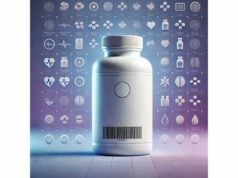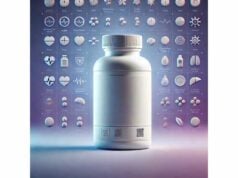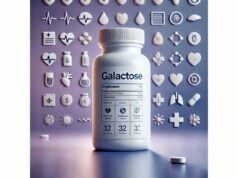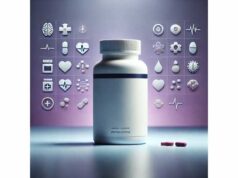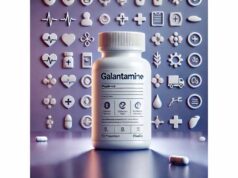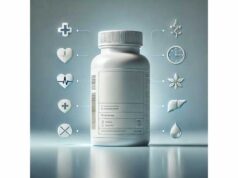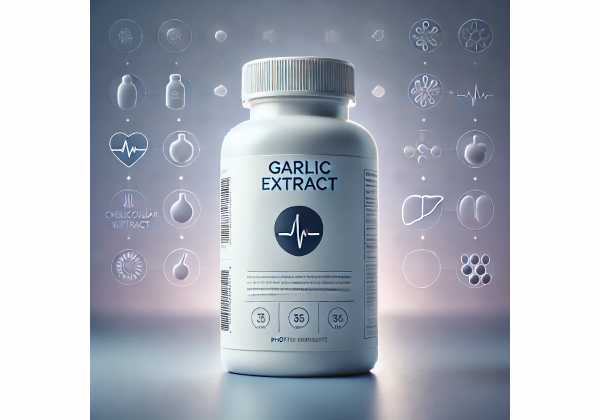
Garlic extract is one of the most widely studied botanical supplements for heart and metabolic health. Derived from Allium sativum, it concentrates organosulfur compounds such as allicin (formed when garlic is crushed) and S-allyl cysteine (SAC) in aged preparations. Across randomized trials and meta-analyses, standardized garlic extracts have shown modest but meaningful support for systolic and diastolic blood pressure, LDL cholesterol, and selected measures of glycemic control. Different preparations—aged garlic extract (odorless, SAC-standardized), enteric-coated garlic powder (allicin-standardized), oils, and black (aged/fermented) garlic—behave differently in the body, so results depend on the form and dose. Used thoughtfully, garlic extract can complement lifestyle and prescription therapy, particularly for adults with early hypertension or borderline lipids. This guide explains how garlic extract works, who benefits, how to choose a quality product, practical dosing, and how to use it safely alongside medications.
Key Insights
- Aged garlic extract supports modest reductions in blood pressure and LDL cholesterol in adults with hypertension or dyslipidemia.
- Evidence for preventing the common cold is limited; immune claims are not conclusive.
- Typical adult dose: 1.2–2.4 g/day aged garlic extract providing ~1.2–2.4 mg SAC, or 600–1,200 mg/day enteric-coated garlic powder standardized for allicin release.
- Stop supplemental garlic before surgery and use caution with anticoagulant or antiplatelet drugs.
- Avoid supplemental doses if you have a bleeding disorder, are pregnant or breastfeeding without medical advice, or are allergic to Allium plants.
Table of Contents
- What garlic extract is
- Evidence-backed benefits
- Choosing a quality product
- How to use garlic extract
- How much garlic extract per day
- Safety, side effects, and interactions
What garlic extract is
Garlic extract is a concentrated preparation from garlic bulbs (Allium sativum) designed to deliver reproducible amounts of bioactive sulfur compounds. The most relevant groups are:
- Allicin and thiosulfinates: Allicin forms when alliin and the enzyme alliinase meet after garlic is cut or crushed. It is reactive, short-lived, and largely responsible for raw garlic’s aroma. Enteric-coated powders are standardized to “allicin potential,” reflecting how much allicin is generated under defined conditions.
- Water-soluble organosulfur compounds from aged garlic extract (AGE): Long, low-heat extraction transforms unstable allicin into stable molecules such as S-allyl cysteine (SAC) and S-allylmercaptocysteine (SAMC). These have predictable absorption; SAC, in particular, is used for standardization.
- Oil-soluble sulfides (e.g., diallyl disulfide, diallyl trisulfide) captured in garlic oils or steam distillates; these differ in bioavailability and effects.
Because chemistry drives effects, the preparation matters:
- Aged garlic extract (AGE): Odorless, SAC-standardized, and consistent from batch to batch. Most modern cardiovascular trials use AGE.
- Garlic powder: Typically enteric-coated tablets standardized to allicin release; quality varies widely.
- Black garlic: Fresh bulbs fermented/aged under heat and humidity. It concentrates SAC and phenolics and softens taste. Some clinical data exist, but fewer trials than AGE.
- Garlic oil: Provides volatile organosulfides; clinical evidence is more limited.
How it likely works. Mechanisms observed in humans and preclinical models include mild vasodilation via nitric oxide and hydrogen sulfide signaling, inhibition of HMG-CoA reductase and cholesterol synthesis, favorable modulation of the gut microbiota, antioxidant effects (lower oxidized LDL), and antiplatelet actions at higher intakes. None of these are drug-strength on their own; benefits are typically additive to diet, exercise, and medications.
Who it is for. Adults with borderline or mild hypertension, elevated LDL cholesterol, prediabetes or type 2 diabetes with dyslipidemia, or those seeking a well-tolerated adjunct for vascular health. For immune support, the research is mixed; expectations should remain modest.
Who should skip or delay. People with bleeding disorders, those scheduled for surgery, or anyone on warfarin, DOACs, or dual antiplatelet therapy, unless a clinician approves a plan that accounts for bleeding risk. Individuals with known Allium allergy should avoid it.
Evidence-backed benefits
Blood pressure (BP). Among adults with elevated BP, standardized garlic extracts produce modest average reductions in both systolic and diastolic values. Contemporary randomized trials and pooled analyses of aged garlic extract report decreases on the order of a few millimeters of mercury—clinically meaningful when layered onto lifestyle changes or medication. The magnitude depends on baseline BP (larger effects when systolic BP starts higher), dose, and adherence. Mechanistically, improved endothelial signaling and reductions in arterial stiffness likely contribute. While response is individual, about half to two-thirds of participants in trials are “responders,” showing ≥5 mm Hg systolic drops. For those already on antihypertensives, garlic can add a small improvement without worsening tolerance in most cases.
Cholesterol and other lipids. Modern systematic reviews of randomized trials show small reductions in LDL cholesterol with garlic supplementation, particularly in individuals with elevated baseline lipids and with longer interventions (≥8–12 weeks). Total cholesterol declines are slightly larger than LDL changes; HDL modestly increases in some analyses. Triglyceride effects are inconsistent. The lipid response appears across preparations (aged extract and powders), but standardized, sustained dosing matters more than taking sporadic capsules.
Glycemic measures. In adults with type 2 diabetes or insulin resistance, pooled data indicate small improvements in fasting blood glucose and HbA1c with garlic supplementation over weeks to months. The glycemic effect size is modest and should be viewed as adjunctive to a well-constructed diet, activity, weight management, and medications when indicated.
Arterial health and inflammation. Trials with aged garlic extract report improvements in surrogate vascular measures: reduced arterial stiffness, favorable shifts in inflammatory markers, and potential slowing of low-attenuation coronary plaque progression in particular contexts. These findings, while encouraging, rely on specialized imaging or biomarkers and are not substitutes for hard cardiovascular outcomes, which require larger, longer trials.
Immune function and the common cold. Evidence is inconclusive. A Cochrane review identified limited, older trials suggesting fewer colds with daily garlic but emphasized uncertainty and the need for replication. If you value this potential, treat it as a possible side benefit of a regimen aimed at cardiometabolic health rather than the primary reason to supplement.
Practical interpretation. For most adults considering garlic extract for heart health, the realistic upside is a modest, steady assist: a few mm Hg off BP, a small nudge down in LDL, and incremental glycemic help. The gains are larger with consistent dosing, a standardized product, and when combined with sodium reduction, DASH-style eating, exercise, and adherence to prescribed therapies. Set expectations accordingly, monitor numbers, and reassess after 8–12 weeks.
Choosing a quality product
Match the form to your goal.
- For BP and LDL: Choose aged garlic extract (AGE) standardized to S-allyl cysteine (SAC). Clinical trials commonly use 1.2–2.4 g/day of AGE providing roughly 1.2–2.4 mg SAC. AGE is odorless and usually well tolerated.
- For allicin-forward strategies: Use enteric-coated garlic powder standardized to allicin release under pharmacopoeia conditions. Enteric coating helps allicin survive the stomach to be generated in the small intestine.
- For culinary enjoyment with some SAC/phenolics: Black garlic is palatable and rich in SAC but has less clinical evidence than AGE.
- For aroma oils: Garlic oil concentrates volatile sulfides; evidence for cardiometabolic outcomes is limited relative to AGE and powders.
Verify standardization and testing.
- Look for labels stating SAC content (for AGE) or allicin potential/release (for powders).
- Prefer brands with third-party testing for identity, potency, and contaminants (for example, NSF/USP/ISO-accredited labs).
- Avoid proprietary blends that hide dose per serving, and be cautious of “odorless” claims that offer no standardization (odor reduction alone is not efficacy).
Check the dose per serving and do the math. If a capsule provides 600 mg AGE with 0.6 mg SAC, two capsules daily reach a common 1.2 g/1.2 mg SAC target. For enteric-coated powders, standardized daily allicin potential often ranges in the low milligram (thousand-microgram) scale—ensure the daily total (not just per tablet) aligns with trial-like dosing.
Read the excipients and allergens. Some tablets add soybean oil, gelatin, or starch. Choose vegetarian capsules if desired and avoid known allergens.
Storage and shelf life. Keep capsules tightly sealed, away from heat and moisture. AGE and SAC are relatively stable; allicin-standardized tablets may lose potency if stored improperly. Do not use products past their expiration.
Recognize red flags. Steer clear of overpromises (e.g., “cures hypertension”), non-specific “detox” language, or products with no lot number. A supplement is an adjunct, not a replacement for evidence-based medical care.
How to use garlic extract
Timing. Most participants in trials take garlic once or twice daily with meals. Taking capsules with food reduces the chance of heartburn, burping, or mild GI upset. Split doses (morning and evening) can improve tolerance and maintain steadier exposure.
Pair with lifestyle for compounding effects. Garlic’s modest effects layer well with:
- A DASH-style or Mediterranean pattern, prioritizing vegetables, legumes, whole grains, nuts, fish, and olive oil.
- Sodium management, aiming for ~1,500–2,300 mg/day unless otherwise directed.
- Regular aerobic activity (e.g., 150 minutes/week of moderate intensity).
- Weight management if overweight; even 5–10% weight loss can markedly improve BP and lipids.
Stacking with other supplements. If your clinician agrees, compatible additions might include omega-3 EPA/DHA for triglycerides, soluble fiber (psyllium, beta-glucan) for LDL, or magnesium for BP in those with low intake. Avoid stacking with other antiplatelet botanicals (e.g., high-dose ginkgo, high-dose fish oil beyond medical guidance) without professional input due to cumulative bleeding risk.
Monitoring. Track BP at home (twice daily, seated, validated cuff) for 2 weeks before and after starting; recheck lipids and A1c at 8–12 weeks if those are your targets. If there is no measurable benefit and you are using a quality, standardized product at an adequate dose, consider discontinuation or a different strategy rather than indefinite use.
When to pause. Stop supplemental garlic before elective procedures as advised by your surgical team. Temporarily hold if you develop unexplained bruising, nosebleeds, black/tarry stools, or signs of an allergic reaction.
Culinary garlic still counts. Cooking with garlic is healthy and delicious, but supplement dosing is distinct. Most culinary uses do not deliver standardized amounts of SAC or allicin. Use both food and supplements thoughtfully—don’t assume one replaces the other.
How much garlic extract per day
Evidence-based adult ranges (typical trial-like dosing):
- Aged garlic extract (AGE, SAC-standardized): 1,200–2,400 mg/day, usually in one to two doses, providing roughly 1.2–2.4 mg/day of SAC. This range is frequently used for blood pressure and LDL support over 8–12+ weeks.
- Enteric-coated garlic powder (allicin-standardized): 600–1,200 mg/day, divided, with labeling that specifies allicin release under pharmacopoeia conditions. Choose products that disclose per-tablet and per-day allicin yield.
- Black garlic extracts: Doses vary with SAC content; research trials have used low SAC doses with small BP effects. If you prefer black garlic, choose a product that states SAC per serving and consider dosing toward SAC totals similar to AGE.
- Garlic oils and distillates: Evidence for cardiometabolic outcomes is limited; follow manufacturer standardization and clinician guidance if used.
Personalizing your dose.
- Start at the lower end (e.g., 600 mg AGE once daily).
- Assess tolerance for a week.
- Titrate toward a full evidence-based target (e.g., 1,200 mg/day AGE) if BP or lipid goals are unmet and side effects are minimal.
- Evaluate at 8–12 weeks. Continue if you see measurable benefit, stop if not.
Special populations.
- Older adults: Start low; monitor closely for interactions with antihypertensives or antiplatelets.
- Diabetes: Because garlic may slightly lower glucose, monitor for hypoglycemia if you use insulin or insulin secretagogues; coordinate with your clinician.
- Pregnancy and breastfeeding: Culinary amounts are generally considered safe, but supplement-level dosing lacks robust data. Avoid unless your obstetric clinician approves.
- Pediatrics: Do not use supplement doses unless directed by a pediatric professional.
What to expect and when. For BP, you may see small average changes within 2–4 weeks, with fuller assessment at 8–12 weeks. Lipid changes typically require 8–12 weeks of steady dosing. If your numbers do not budge and adherence is solid, discuss alternatives with your clinician.
Safety, side effects, and interactions
Common, usually mild effects. Garlic extract is well tolerated for most adults. The most frequent complaints are garlic breath or body odor (less likely with AGE), dyspepsia, gas, nausea, or heartburn. Taking capsules with meals and splitting the dose minimizes symptoms. Skin irritation can occur if raw garlic is applied topically; do not use raw garlic on skin.
Bleeding risk and surgery. Garlic has antiplatelet activity at supplemental doses. Reports and reviews associate higher-dose garlic supplementation with increased perioperative bleeding risk. If you are scheduled for a procedure, inform your clinicians and stop supplemental garlic ahead of surgery as advised by your surgical team.
Medication interactions.
- Anticoagulants and antiplatelets (e.g., warfarin, apixaban, clopidogrel, aspirin): Garlic may increase bleeding risk. Use only with clinician oversight and formal monitoring.
- Antihypertensives: Additive BP lowering is possible; monitor for dizziness or lightheadedness.
- Diabetes medications: Slight additive glucose-lowering may occur—monitor and adjust therapy with your clinician if needed.
- Allergy: Anyone with known Allium allergy (garlic, onions, leeks) should avoid supplementation.
Who should avoid supplemental doses.
- Those with bleeding disorders or a history of easy bruising.
- Anyone awaiting surgery or invasive dental work unless cleared by the surgeon.
- Pregnant or breastfeeding individuals unless specifically advised by a clinician.
- Children unless a pediatric clinician prescribes a product and dose.
Quality and contamination. Choose reputable brands with third-party testing. Counterfeit or poor-quality supplements can be under-dosed or contaminated, undermining both safety and effectiveness.
When to seek medical attention. Stop the product and seek care if you notice unusual bleeding, black or bloody stools, severe abdominal pain, hives or swelling, or signs of anaphylaxis (wheezing, throat swelling). For any worrisome new symptom after starting garlic, contact your clinician.
Bottom line. Garlic extract’s safety profile is favorable at evidence-based doses when used thoughtfully and monitored. The main concern is bleeding risk in susceptible situations or with interacting drugs—plan around surgeries and communicate with your healthcare team.
References
- Effects of aged garlic extract on blood pressure in hypertensive patients: A systematic review and meta-analysis of randomized controlled trials 2024 (Systematic Review)
- Effects of Garlic on Glucose Parameters and Lipid Profile: A Systematic Review and Meta-Analysis on Randomized Controlled Trials 2024 (Systematic Review)
- Antihypertensive Effects of an Optimized Aged Garlic Extract in Subjects with Grade I Hypertension and Antihypertensive Drug Therapy: A Randomized, Triple-Blind Controlled Trial 2023 (RCT)
- Garlic for the common cold 2014 (Systematic Review)
- Dietary supplements and bleeding 2022 (Review)
Disclaimer
This guide is informational and does not substitute for personalized medical advice, diagnosis, or treatment. Always consult a qualified healthcare professional before starting, stopping, or combining supplements—especially if you have medical conditions, take prescription drugs, are pregnant or breastfeeding, or are planning surgery. Never delay seeking professional advice because of something you have read here.
If you found this helpful, consider sharing it with a friend or colleague on Facebook, X, or your favorite platform, and follow us for more evidence-based wellness content. Your support helps us keep creating reliable guides.

